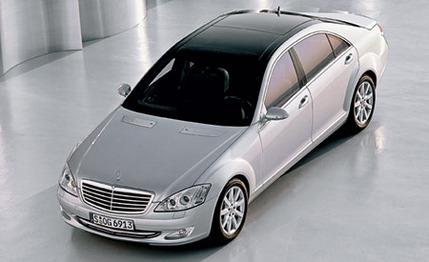
 First Drive Review
First Drive Review
It usually takes between seven and ten years for Mercedes-Benz to spew forth an all-new S-class. As the flagship of a luxury brand that likes to ballyhoo its technological breakthroughs and engineering firsts, many of those years are likely spent thinking of new ways to trump the competition by inventing devices we never knew we needed-rain-sensing wipers-and ones like stability control that'll pull your bacon off the skillet.
So this newest S-class has several features not seen before, but after about 40 years of innovative add-ons, Mercedes has decided to pile all its digital technology into a single system that mimics the dreaded-at least to us-BMW iDrive. The object of our disaffection is a silvery dial the size of an air-hockey puck just forward of the center armrest. But Mercedes says its COMAND controller is the best of the breed and indeed spent hours presenting data and ergonomic studies and showing off multiple interior simulators in an attempt to convince the glassy-eyed auto press that the system is unique and superior to all others.
Sit inside the S-class, and you'll go through a period of frustrating denial in which you'll ask yourself questions like, "Why can't I just have a touch screen?" But the more you play with the dial, the more you realize most of its functions can be operated by other means. Aside from the fundamental settings an owner would likely have to adjust just once-interior ambient lighting, exterior-light shut-off delay, side-bolster inflation-the only time you are forced to use the knob is when you're inputing a destination requiring the navigation system. The sound system can be manipulated by voice or by steering-wheel buttons, HVAC controls are on the dashboard, and the telephone can be operated by voice or by a number pad that sits above the dial. Radio presets have to be entered with the dial, but how often do you really have to change your presets? Compared with the BMW system, it's easier to find your way around and harder to get stuck.
A result of the COMAND knob is that the new interior doesn't concentrate buttons and switches in any single place, the idea being that you won't be overwhelmed by numerous look-alike buttons. The switchgear that remains has a metallic finish reminiscent of high-end electronic gear. The interior has a very 7-series-like feel because of the large monitor that sits high atop the dashboard, the now-column-mounted shifter, and of course that dial. It's a slightly more spacious place than in the previous S-class, owing to a wheelbase 3.1 inches longer, another inch in height, and just over a half-inch in width.
The similarities to the big BMW end when it comes to the exterior styling of the S-class. There's a slightly raised trunk that might be compared with that of the 7-series, but the cue evokes Maybach, not Bangle. The S-class has an immediately likable design that is more handsome and aggressive than its predecessor's. Character lines and large fender flares that house standard 18-inch wheels and optional 19-inchers give the sedan a sporty, determined stance.
Initially, two models will be available: the 382-hp, 5.5-liter V-8-powered S500 and the 510-hp twin-turbocharged V-12 S600. The V-8 makes 80 more horsepower than the previous generation, thanks to new DOHC heads, four valves per cylinder, and more displacement. The SOHC 5.5-liter V-12 remains the same except for a few engine-management tweaks that unearthed 17 hidden horses. Despite a slight weight gain, Mercedes claims the new car will outrun the previous model.
Mercedes also claims its new sedan is its safest yet. S-classes equipped with optional Distronic Plus cruise control go beyond the standard car's safety features with a short-range radar system that "looks" at an area closer to the front of the vehicle than the long-range radar used by the cruise control. Information from the short-range system is used to increase the effectiveness of the brake-assist system (brake assist adds braking power in emergency situations, when most drivers apply insufficient pedal pressure) by adding brake pressure even faster when the radar senses objects in front of the vehicle. In cruise mode, the S-class will now come to a complete stop if traffic does and will start up again on its own.
Working in concert with the short-range radar is a more advanced version of Mercedes' Pre-Safe system that adjusts seatbelt tension, inflates various seat bolsters, and raises any open windows to prepare occupants for a collision when the radar "determines" that an accident is imminent. The standard version of Pre-Safe prepares occupants for a collision based on the sensors used by the stability-control system.
For those who really enjoy ticking off the options boxes, there are more cameras to be had than are present in the women's lavatory at Chuck Berry's restaurant. There's an infrared camera that gives the driver a view of the road beyond the headlights' range. In back there's an optional rearview camera that gets rid of the old model's parking sensors. A well-optioned S500 should easily crest $100,000.
The current S-class has been a strong seller at nearly half a million units. It remains to be seen how its traditionally wealthy, older owners who probably saw 2001: A Space Odyssey in the theater will react to the COMAND controller. But the additional safety and luxury features, performance, and style are what we expect from a new S-class. Of course, we also expect effortlessly capable driving qualities. We'll tell you about that when we get behind the wheel in a few months.